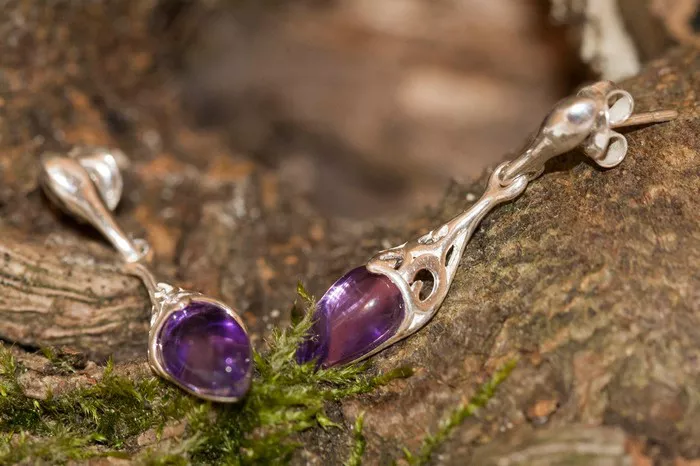An amethyst necklace is a piece of jewelry that has a rich history and significant symbolism attached to it. Made from the semiprecious gemstone amethyst, this necklace is not just an accessory but a representation of various cultural, mystical, and spiritual beliefs. This article aims to provide a comprehensive understanding of the meaning behind an amethyst necklace, its historical significance, and its various interpretations across different cultures and times.
Historical Significance
The history of amethyst dates back thousands of years. Ancient civilizations, including those in Greece, Rome, and Egypt, revered this gemstone for its unique purple hue and believed it possessed mystical powers. In Greek mythology, amethyst is said to have been named by Dionysus, the god of wine and revelry, after he became enraged with one of his lovers, Amethyste, who refused to honor his advances. To prevent her from ever being intoxicated again, Dionysus turned her into a stone with a liquor-like purple color, hence the name amethyst, derived from the Greek words “a” (not) and “methustos” (intoxicated).
This mythological tale has given amethyst a reputation for being a stone that prevents drunkenness and promotes sobriety. However, its significance extends beyond mere abstinence from alcohol. In ancient times, amethyst was also believed to ward off evil spirits, protect against poisoning, and bring clarity to the mind. These beliefs were so ingrained in society that amethyst was often used in religious ceremonies and worn by royalty and the upper classes as a symbol of their status and power.
Gemological Characteristics
Amethyst is a variety of quartz that displays a beautiful purple color due to trace amounts of manganese and iron in its crystal structure. The intensity of its color can range from a light lavender to a deep, almost royal purple. This gemstone is relatively hard, with a Mohs hardness of 7, making it durable enough for everyday wear.
Amethyst can be found in various locations worldwide, including Brazil, Uruguay, Sri Lanka, and Madagascar. Each deposit tends to produce stones with slightly different shades and tones, giving amethyst a unique appearance that can vary greatly from one piece to another.
When it comes to jewelry, amethyst is often cut into various shapes and sizes to fit different pieces, including necklaces. The most common cuts for amethyst necklaces are round, oval, and pear shapes, but more intricate cuts like cabochons and fantasy cuts are also used to create unique and eye-catching designs.
Cultural Symbolism
The meaning of an amethyst necklace can vary greatly depending on the culture and context in which it is worn. Here are some of the most common interpretations:
Protection and Healing:Across many cultures, amethyst is believed to possess protective qualities. It is thought to shield the wearer from negative energy, evil spirits, and even physical harm. In some traditions, amethyst is also used for healing purposes, particularly for issues related to the mind and emotions. It is believed to soothe anxiety, stress, and anger, promoting a sense of calm and serenity.
Sobriety and Temperance:As mentioned earlier, the Greek mythology surrounding amethyst has given this gemstone a reputation for promoting sobriety and temperance. Many people wear amethyst necklaces as a reminder to stay focused, avoid excess, and maintain a healthy lifestyle.
Creativity and Spirituality:Amethyst is often associated with creativity and spirituality. Many artists, writers, and musicians wear amethyst jewelry to inspire their creativity and enhance their imagination. Additionally, amethyst is believed to be a stone of meditation and spiritual growth, helping the wearer to connect with their inner self and achieve a deeper understanding of the world.
Love and Relationships:In some cultures, amethyst is also seen as a stone of love and relationships. It is believed to promote fidelity, strengthen bonds between partners, and bring harmony to relationships. Many people give amethyst necklaces as gifts to their loved ones to symbolize their commitment and affection.
Modern Interpretations
In modern times, the meaning of an amethyst necklace has evolved to fit the needs and beliefs of contemporary society. While some people still hold onto the traditional beliefs surrounding amethyst, many others wear it for its aesthetic value or as a personal symbol of their own choosing.
For example, some people wear amethyst necklaces as a reminder of their personal strengths and goals. They may see the gemstone’s color as a representation of their unique personality or as a symbol of their journey towards self-discovery.
Others may wear amethyst as a way to honor a loved one who has passed away. The gemstone’s beautiful purple hue can serve as a reminder of the person’s spirit and the love they shared.
Still, others may simply wear amethyst necklaces because they find the gemstone’s color and appearance appealing. In this case, the necklace may not have any particular meaning beyond its aesthetic value.
Jewelry Design and Styles
Amethyst necklaces come in a wide variety of designs and styles, catering to different tastes and preferences. Some necklaces feature a single, large amethyst pendant, while others may have multiple smaller stones set in a delicate chain.
The metal used to craft the necklace can also vary, with options such as sterling silver, gold, and rose gold being popular choices. The metal’s color and finish can add to the overall aesthetic of the necklace, making it more suitable for different occasions and outfits.
In addition to traditional necklace designs, amethyst can also be incorporated into more unique and innovative pieces. For example, some jewelers may create amethyst pendants that are shaped like animals, flowers, or other symbols. These pieces can serve as unique and meaningful gifts for loved ones or as a way to express one’s personal style.
Conclusion
An amethyst necklace is a piece of jewelry that holds a wealth of meaning and symbolism. Its historical significance, gemological characteristics, and cultural interpretations make it a unique and special gemstone that has been cherished by people for thousands of years.
- Amethyst Hexagonal Crystal: How Its Shape Affects Its Energy
- How Is Amethyst Rock Formed?
- How Is Amethyst Chair Made?


